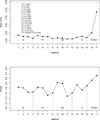Powerful multi-marker association tests: unifying genomic distance-based regression and logistic regression - PubMed (original) (raw)
Powerful multi-marker association tests: unifying genomic distance-based regression and logistic regression
Fang Han et al. Genet Epidemiol. 2010 Nov.
Abstract
To detect genetic association with common and complex diseases, many statistical tests have been proposed for candidate gene or genome-wide association studies with the case-control design. Due to linkage disequilibrium (LD), multi-marker association tests can gain power over single-marker tests with a Bonferroni multiple testing adjustment. Among many existing multi-marker association tests, most target to detect only one of many possible aspects in distributional differences between the genotypes of cases and controls, such as allele frequency differences, while a few new ones aim to target two or three aspects, all of which can be implemented in logistic regression. In contrast to logistic regression, a genomic distance-based regression (GDBR) approach aims to detect some high-order genotypic differences between cases and controls. A recent study has confirmed the high power of GDBR tests. At this moment, the popular logistic regression and the emerging GDBR approaches are completely unrelated; for example, one has to choose between the two. In this article, we reformulate GDBR as logistic regression, opening a venue to constructing other powerful tests while overcoming some limitations of GDBR. For example, asymptotic distributions can replace time-consuming permutations for deriving P-values and covariates, including gene-gene interactions, can be easily incorporated. Importantly, this reformulation facilitates combining GDBR with other existing methods in a unified framework of logistic regression. In particular, we show that Fisher's P-value combining method can boost statistical power by incorporating information from allele frequencies, Hardy-Weinberg disequilibrium, LD patterns, and other higher-order interactions among multi-markers as captured by GDBR.
© 2010 Wiley-Liss, Inc.
Figures
Figure 1
Empirical Type I error and average power of various tests at the nominal level of 0.05 for simulated data.
Similar articles
- Single-marker and two-marker association tests for unphased case-control genotype data, with a power comparison.
Kim S, Morris NJ, Won S, Elston RC. Kim S, et al. Genet Epidemiol. 2010 Jan;34(1):67-77. doi: 10.1002/gepi.20436. Genet Epidemiol. 2010. PMID: 19557751 Free PMC article. - Relationship between genomic distance-based regression and kernel machine regression for multi-marker association testing.
Pan W. Pan W. Genet Epidemiol. 2011 May;35(4):211-6. doi: 10.1002/gepi.20567. Genet Epidemiol. 2011. PMID: 21308765 Free PMC article. - Comparison of multimarker logistic regression models, with application to a genomewide scan of schizophrenia.
Wason JM, Dudbridge F. Wason JM, et al. BMC Genet. 2010 Sep 9;11:80. doi: 10.1186/1471-2156-11-80. BMC Genet. 2010. PMID: 20828390 Free PMC article. - OPATs: Omnibus P-value association tests.
Chen CW, Yang HC. Chen CW, et al. Brief Bioinform. 2019 Jan 18;20(1):1-14. doi: 10.1093/bib/bbx068. Brief Bioinform. 2019. PMID: 28981573 Free PMC article. Review. - On selecting markers for association studies: patterns of linkage disequilibrium between two and three diallelic loci.
Garner C, Slatkin M. Garner C, et al. Genet Epidemiol. 2003 Jan;24(1):57-67. doi: 10.1002/gepi.10217. Genet Epidemiol. 2003. PMID: 12508256 Review.
Cited by
- Selecting Genetic Variants and Interactions Associated with Amyotrophic Lateral Sclerosis: A Group LASSO Approach.
Feronato SG, Silva MLM, Izbicki R, Farias TDJ, Shigunov P, Dallagiovanna B, Passetti F, Dos Santos HG. Feronato SG, et al. J Pers Med. 2022 Aug 19;12(8):1330. doi: 10.3390/jpm12081330. J Pers Med. 2022. PMID: 36013279 Free PMC article. - Detection of epigenetic field defects using a weighted epigenetic distance-based method.
Wang Y, Qian M, Ruan P, Teschendorff AE, Wang S. Wang Y, et al. Nucleic Acids Res. 2019 Jan 10;47(1):e6. doi: 10.1093/nar/gky882. Nucleic Acids Res. 2019. PMID: 30304472 Free PMC article. - Rare variants analysis using penalization methods for whole genome sequence data.
Yazdani A, Yazdani A, Boerwinkle E. Yazdani A, et al. BMC Bioinformatics. 2015 Dec 4;16:405. doi: 10.1186/s12859-015-0825-4. BMC Bioinformatics. 2015. PMID: 26637205 Free PMC article. - A multi-SNP association test for complex diseases incorporating an optimal P-value threshold algorithm in nuclear families.
Wang YT, Sung PY, Lin PL, Yu YW, Chung RH. Wang YT, et al. BMC Genomics. 2015 May 15;16(1):381. doi: 10.1186/s12864-015-1620-3. BMC Genomics. 2015. PMID: 25975968 Free PMC article. - Family-based association analysis: a fast and efficient method of multivariate association analysis with multiple variants.
Won S, Kim W, Lee S, Lee Y, Sung J, Park T. Won S, et al. BMC Bioinformatics. 2015 Feb 15;16:46. doi: 10.1186/s12859-015-0484-5. BMC Bioinformatics. 2015. PMID: 25887481 Free PMC article.
References
- Chapman JM, Cooper JD, Todd JA, Clayton DG. Detecting disease associations due to linkage disequilibrium using haplotype tags: a class of tests and the determinants of statistical power. Hum Hered. 2003;56:18–31. - PubMed
- Chen J, Chatterjee N. Exploiting Hardy-Weinberg equilibrium for efficient screening of single SNP associations from case-control studies. Human Heredity. 2007;63:196–204. - PubMed
Publication types
MeSH terms
Substances
Grants and funding
- R01 GM081535/GM/NIGMS NIH HHS/United States
- GM081535/GM/NIGMS NIH HHS/United States
- R01 HL065462-09/HL/NHLBI NIH HHS/United States
- R01 HL065462/HL/NHLBI NIH HHS/United States
- R01 GM081535-04/GM/NIGMS NIH HHS/United States
- HL65462/HL/NHLBI NIH HHS/United States
- R01 HL065462-08/HL/NHLBI NIH HHS/United States
LinkOut - more resources
Full Text Sources
Research Materials
